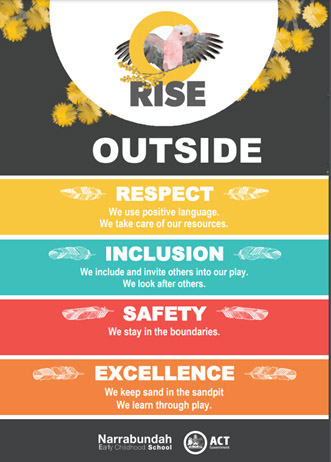Explicit teaching of Social and Emotional Learning (SEL) is explicitly taught in all classrooms
At NECS Friendly Schools Plus, Playing and Learning to Socialise (PALS) and the Social and Personal Capabilities from the Australian Curriculum guide the explicit teaching of social and emotional learning (SEL) in the classroom. Educators plan for and implement regular SEL lessons and in K-2 social and personal capabilities are reported on in the Semester 1 and Semester 2 formal report to families.
At NECS we intentionally develop a consistent language to discuss emotions and to support children to communicate and regulate their feelings effectively. The Zones of Regulation consist of four coloured zones: blue, green, yellow and red. Each zone reflects a range of feelings and emotions. Children can name the zone they are in and then identify the feeling within the zone. To support emotional regulation and wellbeing, children explore and create an individual zone card with a range of sensory and mindfulness tools to support them to get back to green zone, the optimal zone for learning. Through regular daily zone check ins e.g. on arrival at school, after play breaks educators are able to proactively support children’s emotional wellbeing.

Active supervision and positive engagement with children in the playground are a core component of supporting children’s wellbeing and is key to the prevention of negative incidents. On the playground:
- All staff wear a high-vis vest when supervising children in the playground. This allows children to identify supervising adults more quickly and seek help when necessary.
- Adults actively walk around the playground when supervising children.
- Adults regularly check areas such as the maze, the cubby house etc.
- Adults are aware of children requiring greater support to have positive interactions with others on the playground.
- Adults proactively intervene if they ‘see’ or ‘hear’ a child indicate they are not coping, or that an incident is about to occur. Adults play an integral role in preventing small incidents turning into larger incidents.
- Adults engage with children as they play e.g. engage in conversation, interact in the children’s play, assist children to play together etc.
- Supervising staff are expected to actively supervise all areas of the playground, including the toilets in the playground.

Playground/Outside expectations:
- NECS RISE expectations are on display in the playground to guide all reminders, redirections, and behaviour expectations.
- Supervising staff use RISE language to actively promote positive behaviours on the playground.
- Supervising adults engage in restorative questions to solve small incidents and/or use the use of natural consequences such as cleaning up an area that has been broken or the ‘walk with me’ strategy if a child requires some calm down time or time out.
- Children are actively taught how to use resources and equipment safely in the playground. As they are children this may take modelling and repetition.
- Supervising adults to teach positive play behaviours and how to engage safely with equipment.
Educators use the restorative conversation process to help children repair relationships when harm has occurred.
Questions that guide discussion with the children who have done the wrong thing……
- What happened?
- What were you thinking about at the time?
- What have you thought about since?
- Who has been affected by what you have done? In what way?
- What do you think you need to do to make things right again?
Questions that guide discussion with those who have been harmed……
- What did you think when you realised what had happened?
- What impact has this incident had on you and others?
- What has been the hardest thing for you?
- What do you think needs to happen to make things right?
Each incident is analysed and investigated with the children and educator/s involved and recorded on Sentral if deemed to be necessary. At all times educators are encouraged to use natural consequences to guide the ‘next steps’. For example, if a child hurts another child during an incident, we might decide that the child did not demonstrate safe behaviours and as such they may lose some time on the playground with peers. Depending on the nature of the incident this may vary from five minutes to a few days off the playground. Educators use tools such as social stories to help teach the child replacement behaviours.
Teaching replacement behaviours takes time. Children need support from educators and family and repeated opportunities to practice the replacement skills and strategies both when they are calm and when they are heightened.
If a child repeatedly engages in negative interactions several steps may occur:
- Educators will meet with the family to discuss the issue
- A social story may be created to help the child/ren understand the problem and the desired behaviours
- A referral may be submitted to the School Psychologist (requires consent from the child’s family)
- A Positive Behaviour Support Plan may be created
- A referral to the NSET team may be submitted (requires consent from the child’s family)
If a child indicates that they do not feel safe on the playground, with a particular peer, in a particular situation etc. a range of strategies can be implemented. All actions aim to help the child to feel safe at school. Interventions such as the use of social stories, allocated play spaces, alternative play spaces, the development of improved peer relationships and friendships, explicit teaching of social skills such as resilience etc. Educators will collaborate and work with the child and their family to ensure everyone is clear on the steps being implemented to support the child. The plans will be reviewed as needed.
